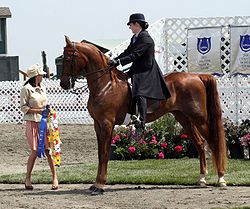 A The American Saddlebred with its conformation, personality, and stamina is suited to accomplish any task requested, but is most well-known as the "peacock of the horse show world." The horses used for Saddle seat and fine harness competition, the disciplines where the breed dominates, are flashy, high-stepping animals, with exaggerated action. Saddlebreds are sometimes used in western classes and in the sport horse disciplines. The Saddlebred is very sensitive and alert. The ideal American Saddlebred is well-proportioned and presents a beautiful overall picture. Large, wide-set expressive eyes and gracefully shaped ears set close together are positioned on a well-shaped head. The neck is long with a fine, clean throatlatch and is arched and well-flexed at the poll. The American Saddlebred sports well-defined and prominent withers, while the shoulders are deep and sloping. Well-sprung ribs and a strong level back also characterize the breed. The legs are straight with broad flat bones, sharply defined tendons and sloping pasterns. Saddlebreds are usually black, bay, or chesnut, but grays, buckskins, palominos, pintos and occasionally roans are also seen. The average height is 15 to 16 hands (60 to 64 inches, 152 to 163 cm), but can range from 14.2 to 17 hands (58 to 68 inches, 147 to 173 cm).
A The American Saddlebred with its conformation, personality, and stamina is suited to accomplish any task requested, but is most well-known as the "peacock of the horse show world." The horses used for Saddle seat and fine harness competition, the disciplines where the breed dominates, are flashy, high-stepping animals, with exaggerated action. Saddlebreds are sometimes used in western classes and in the sport horse disciplines. The Saddlebred is very sensitive and alert. The ideal American Saddlebred is well-proportioned and presents a beautiful overall picture. Large, wide-set expressive eyes and gracefully shaped ears set close together are positioned on a well-shaped head. The neck is long with a fine, clean throatlatch and is arched and well-flexed at the poll. The American Saddlebred sports well-defined and prominent withers, while the shoulders are deep and sloping. Well-sprung ribs and a strong level back also characterize the breed. The legs are straight with broad flat bones, sharply defined tendons and sloping pasterns. Saddlebreds are usually black, bay, or chesnut, but grays, buckskins, palominos, pintos and occasionally roans are also seen. The average height is 15 to 16 hands (60 to 64 inches, 152 to 163 cm), but can range from 14.2 to 17 hands (58 to 68 inches, 147 to 173 cm).
Saddlebreds can also be five-gaited, performing not only the walk, trot, and canter, but also ambling gaits known as the slow-gait and the rack. The slow gait is one of three possible four-beat gaits performed at a relatively slow speed only slightly faster than the walk, with substantial knee action. The slow gait may be the lateral, even-tempo singlefoot, the lateral, asynchronous stepping pace, or the diagonal fox trot. The rack is a ground-covering lateral four-beat gait, and is much faster, with the horse snapping their knees and hocks up quickly. Ancestors of the Saddlebred were naturally gaited, and many Saddlebreds today can learn the additional gaits.
